Is the Calvine UFO actually a distant mountaintop peeking through the mist?
Lots of people think it might be but would this be possible?

One of the many explanations for the Calvine image that is often shared online is that the UFO is not an unknown craft as many believe, but rather the peak of a distant mountain protruding through a sea of cloud resulting from a cloud inversion. Given how frequently this explanation is shared and the extent to which it has become part of the mythology surrounding the Calvine UFO sighting I thought it might be worth exploring this suggestion in detail.
As far as I’ve been able to establish this idea was first suggested by Gordon Hudson in a Twitter post dated 1.31pm on the 16th August 2022 (BST) just three days after the publication of the original Calvine image in the Daily Mail (link) and on Dr David Clarke’s blog (link). Hudson noted the similarity between the unknown object seen in the Calvine photograph (the ‘UFO’) and a distant peak (Farragon Hill, 782m) present in photographs of the location believed to be the most likely site for the Calvine photograph. Hudson was able to produce a fairly good match by overlaying the Calvine image on top of the landscape which led him to suggest we might be looking at an image of a cloud inversion. Although Hudson later deleted his post this explanation subsequently became part of the folklore surrounding the Calvine sighting and persists to this day.
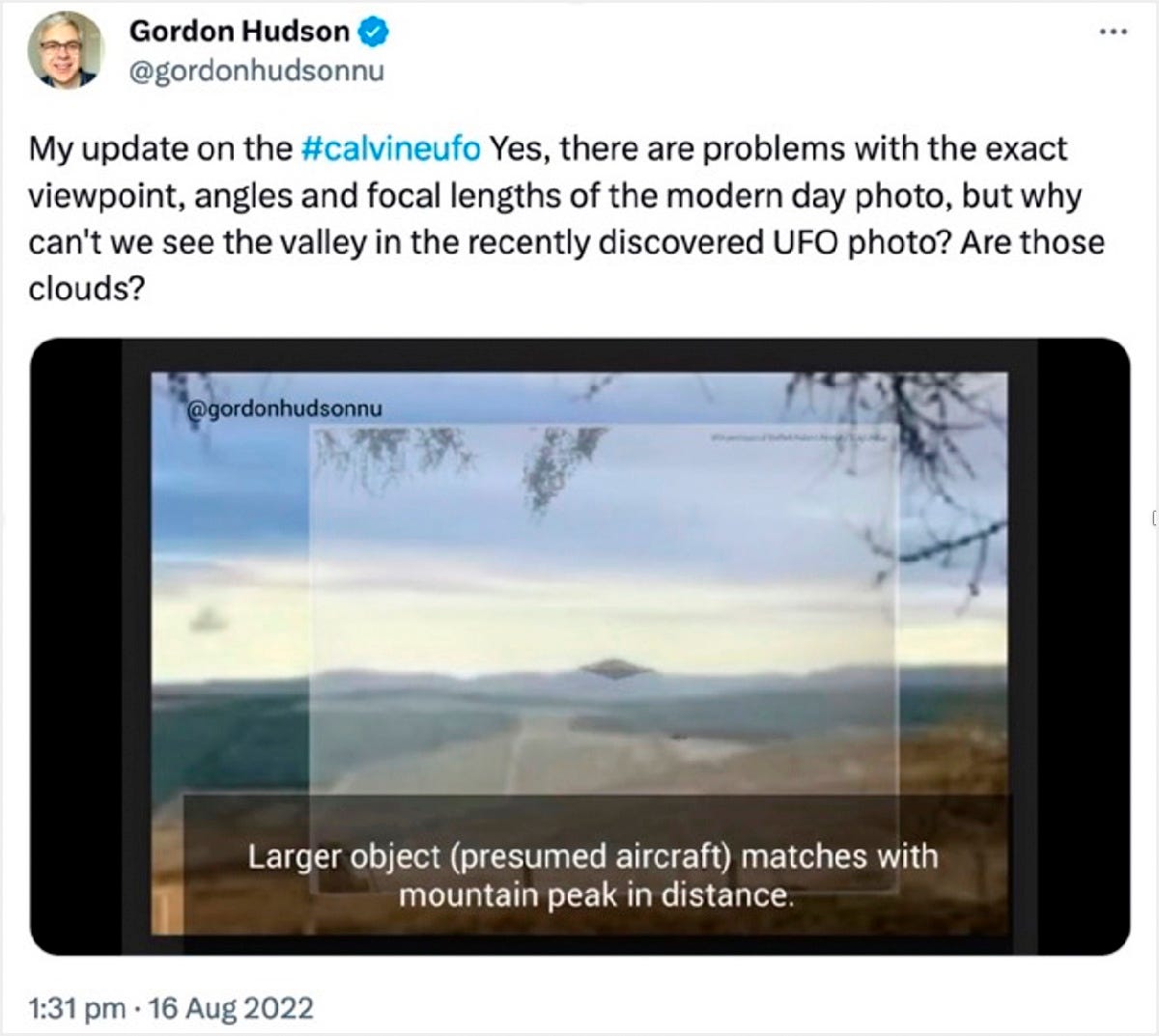
In March 2023 Mike Bara posted a YouTube video in which he claims he has ‘solved the Calvine UFO photograph’ (see here). In the video he explains that the image is actually a photograph of a distant peak emerging above a blanket of cloud obscuring the landscape below due to a cloud inversion in the same manner, and using the same images as Gordon Hudson. This claim was picked up by the Daily Express who included it in a story they ran on the Calvine UFO in September 2024 (see here).
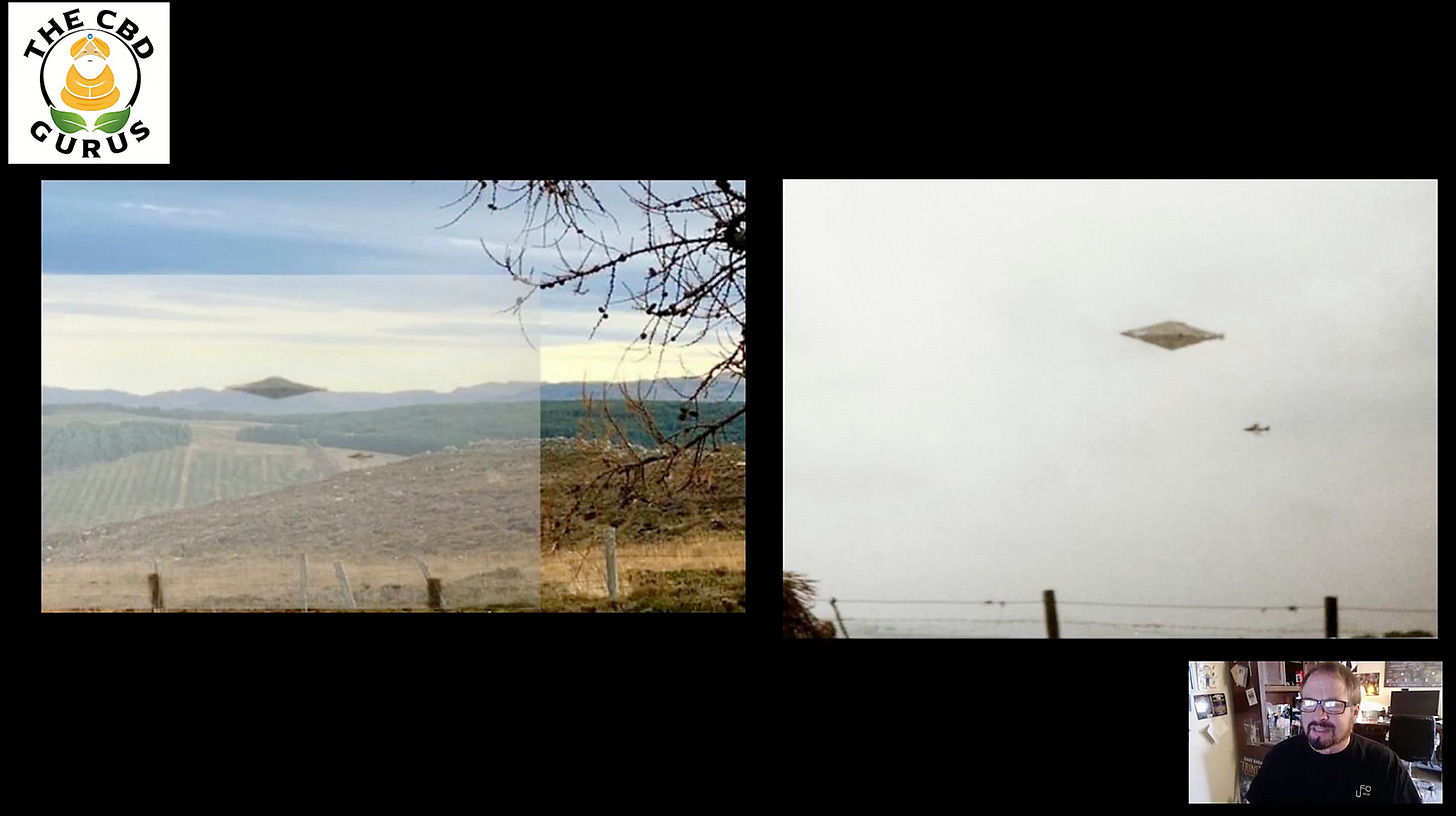
Bara bases his argument on a comparison of the original Calvine Photograph with a photograph which he claims, “was taken from the spot where the Calvin UFO was photographed”. In the video he overlays a cropped version of the Calvine photograph on top of a photograph taken from An Teampan on the moors to the south of Calvine (see above). This overlay, in which the image of the Calvine UFO appears to be a match for the peak of the distant mountain of Farragon Hill (782m) in the image beneath, forms the basis of his claim. Unfortunately, this landscape photograph, (which was actually taken by local resident Giles Stevens and is used in Bara’s video without proper credit) does not show the true location where the sighting took place. Indeed, to date no conclusive evidence exists to indicate where the Calvine photograph was actually taken. The original witnesses simply said that they parked at Calvine and climbed onto the moors above and there is insufficient information in either their report or the Calvine UFO photograph itself to determine an exact location.
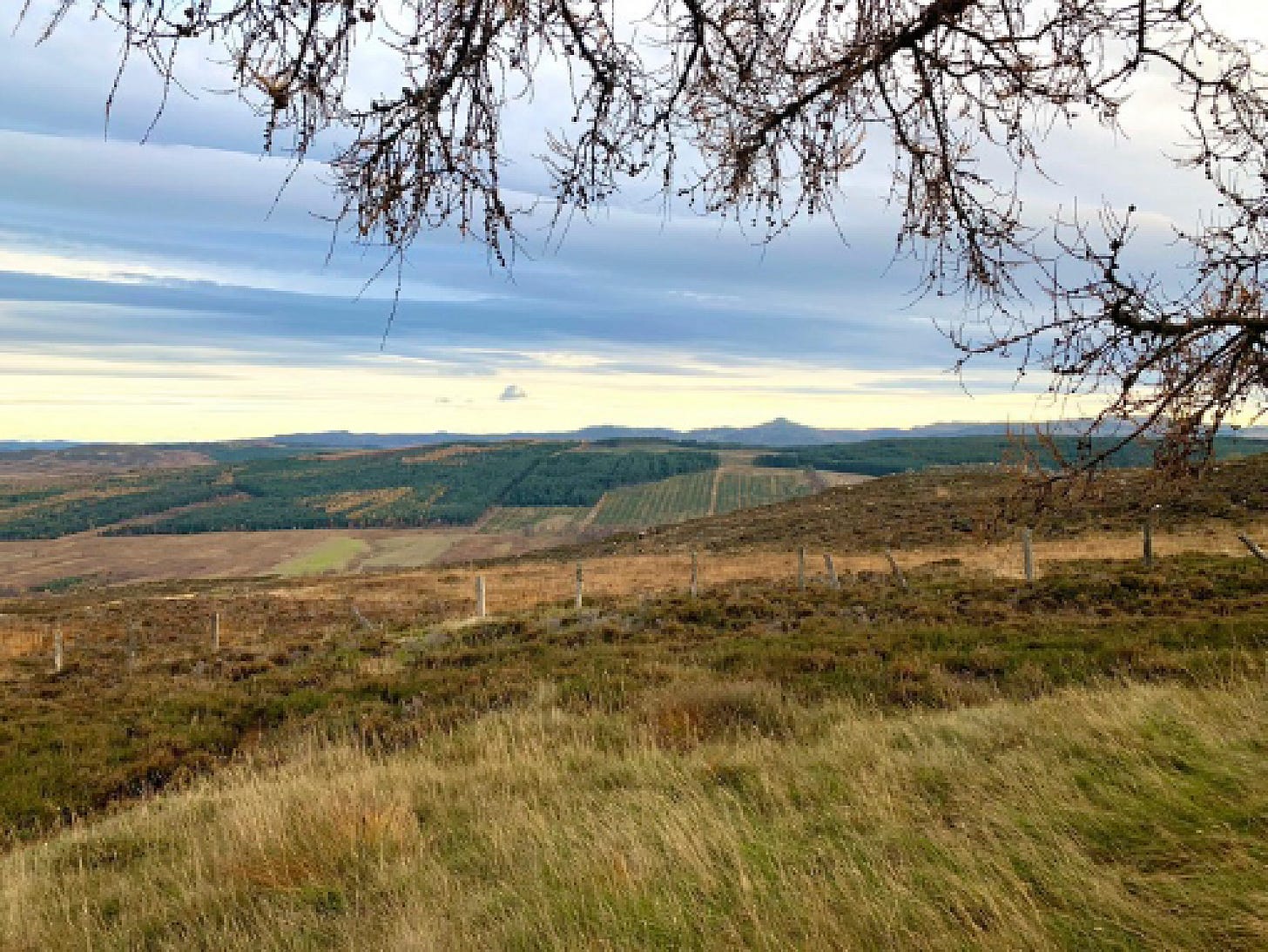
We have have suggested An Teampan as a possible location based on its elevation, the view, the tree cover and fencing present and photographs of this location have been shared online and reproduced in the press and TV documentaries. Nevertheless, whilst this is a convincing possibility, there is no conclusive proof that this is indeed where the Calvine sighting took place, and the possibility exists that the image could have been produced somewhere else entirely. Further discussion of the location of the Calvine sighting can be found on pages 26-28 of my report which can be found here.

Detailed comparison of the peaks of Farragon Hill and Ben Vrackie (recently suggested as another possible peak) reveal that whilst there is some similarity in shape between these peaks and the Calvine UFO they do not in fact match at all.
A further problem with Bara’s claims is that we do not know what camera was used by the witnesses nor the focal length of the lens that produced the Calvine image. The focal length determines the field of view of the camera and the representation of space with the photograph, a longer focal length lens (e.g. a telephoto lens) compresses space while a shorter focal length lens (e.g. a wide-angle lens) expands and stretches space. Without this information it is impossible to gain any accurate information or understanding from overlaying or compositing images taken on different cameras without knowledge of the relative focal lengths of their lenses. In addition, in his analysis Bara uses a cropped version of the Calvine image where important detail along all four sides of the image is excluded. This allows him to line up the images in a convincing manner and provide a fairly good ‘fit’ of the UFO over Farragon Hill however excludes important visual detail.
Bara is proposing a cloud inversion in order to explain the lack of any visible landscape between the fence at the bottom of the Calvine photograph and the object in the sky. A simple explanation for this is that the photograph was taken from a low angle looking up at the sky above. If an uncropped version of the Calvine image is carefully examined a distant horizon is actually visible behind the fence along the lower edge of the image where I believe is possible to just make out the shape of the very peak that he claims to be forming the image of the UFO in the clouds above.

Bara’s analysis of the image is thus fundamentally flawed and his resulting conclusions regarding the suggested relationship between the UFO and the peak of Farragon Hill have no evidential basis.
More recently in early October 2024 I was contacted by a journalist from a Scottish newspaper regarding a claim posted on Facebook that also suggests a cloud inversion explanation for the Calvine UFO naming a mountain to the north of Calvine, Ben Vrackie, as a possibility. (see my discussion of this suggestion here).

It’s worth considering if a cloud inversion could ever isolate the two peaks that have been suggested (Farragon Hill, 782m and Ben Vrackie, 841m) above a sea of white mist when viewed from An Teampan (420m) at 9.00pm on a summers evening.
Cloud inversions typically occur in the early mornings shortly after dawn following a cold, cloud free night when the lack of cloud cover allows the ground to lose all of its heat from the previous day. The ground cools the air above it and if the temperature of this air falls to below the ‘Dew Point,’ then water vapour condenses producing low lying cloud. This mist hugs then the valley bottoms appearing like a sea of cloud when viewed from above (further info here and here).
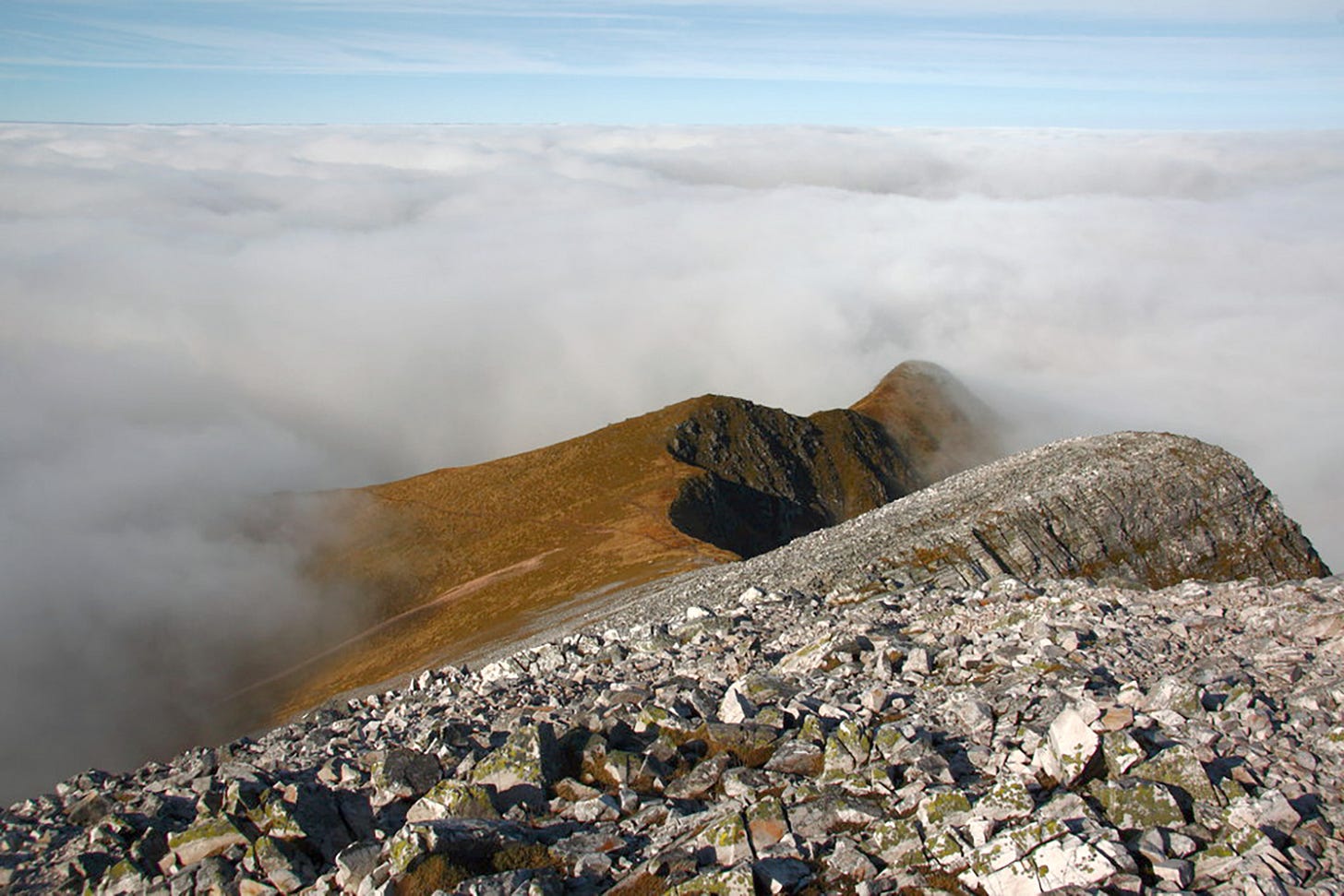
The upper surface of a cloud inversion typically shows an undulating fluffy cloud like texture rather than the even background seen in the Calvine UFO image (see some more images of cloud inversions in the Scottish Highlands here). It would be highly unlikely that a cloud inversion could produce a smooth level surface of mist stretching from the photograph’s location across numerous valleys and ridges to a distant mountain peak.
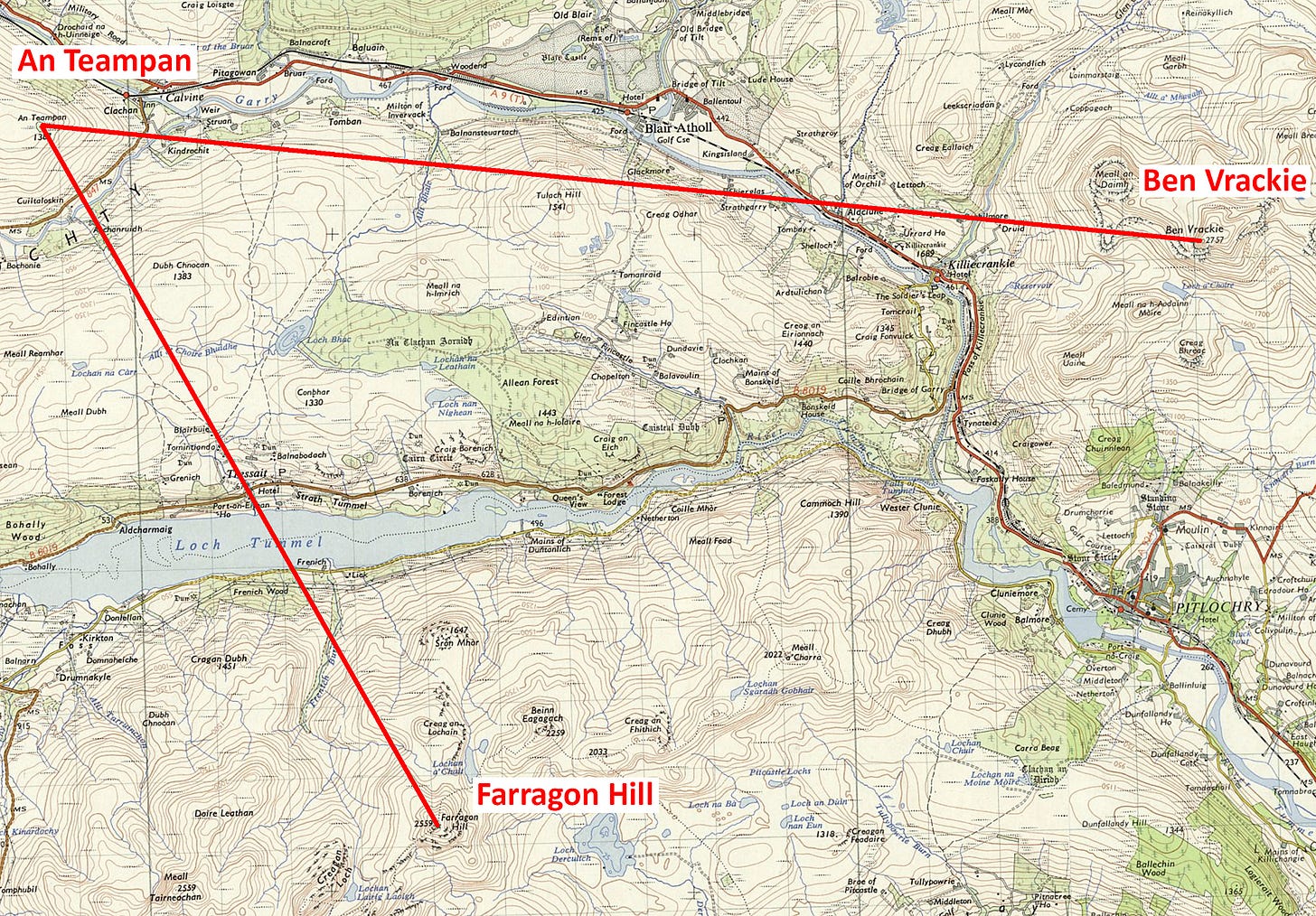
In addition, the most likely location for the Calvine photograph, An Teampan (422m), is at a much lower elevation than either of the two distant mountains, Ben Vrackie, 841m and Farragon Hill, 782m. The relatively low elevation of this site means that if there was a cloud inversion where An Teampan was above the clouds, and we were to look south-east towards Farragon Hill some 7.18 miles away, Dubh Chnocan (422m) would be seen protruding from the mist on the opposite side of the valley immediately in front of us. Likewise, if we were to turn and look eastwards towards Ben Vrackie 10.2 miles away, we would see Tulach Hill (470m) in our direct line of sight. In addition if the entire area was covered by low lying cloud creating a sea of mist above these hills all the way to the peak of either Farragon Hill or Ben Vrackie, then An Teampan itself would be shrouded in mist at least 50m beneath the top of the cloud layer.
So, I’m afraid that despite Mike Bara’s claims to the contrary, the Calvine mystery remains ‘unsolved’ and it is clear that the Calvine UFO has never been a distant mountaintop peeking through the mist of a Scottish summer evening.
© Andrew Robinson, 2024.

